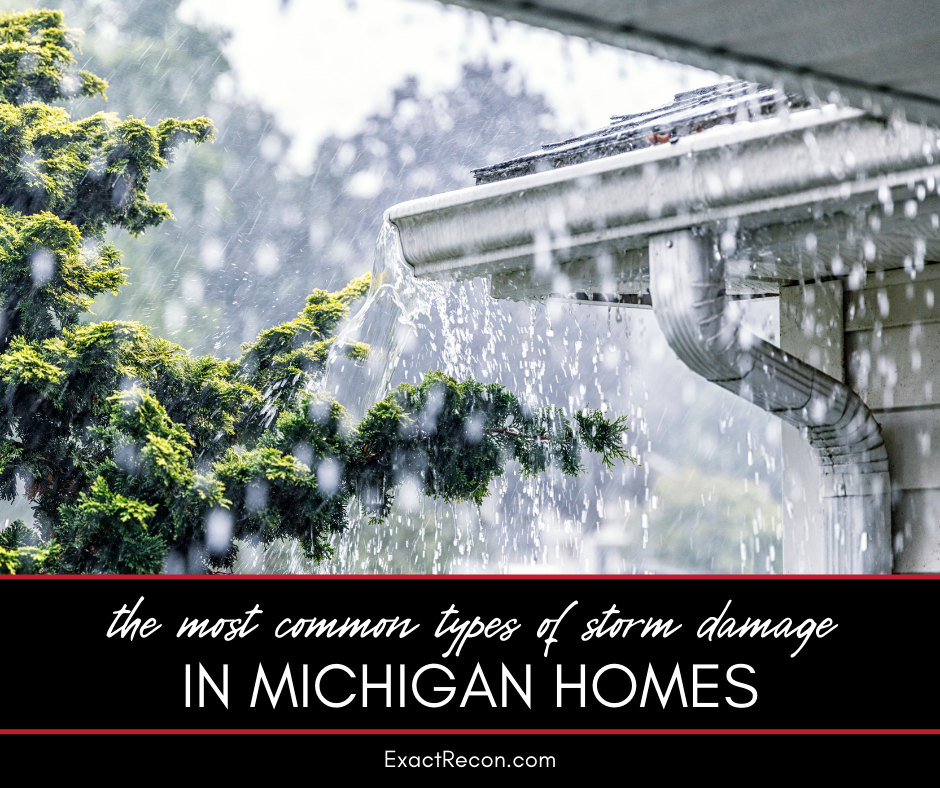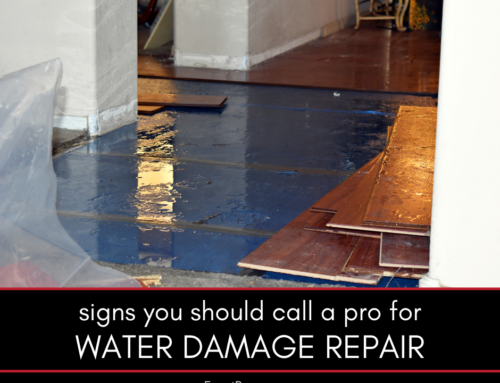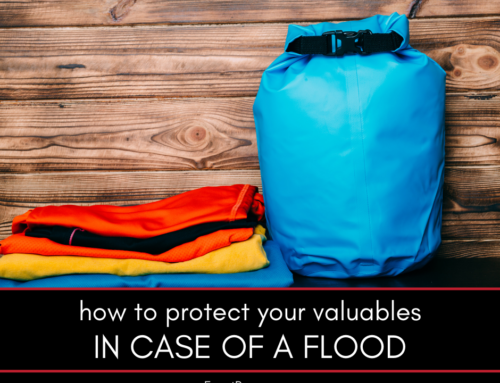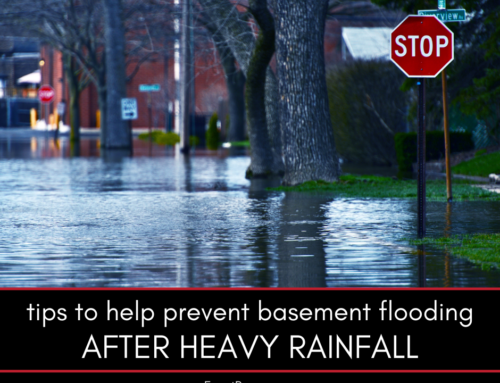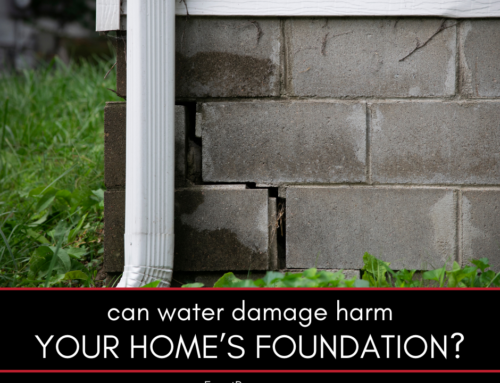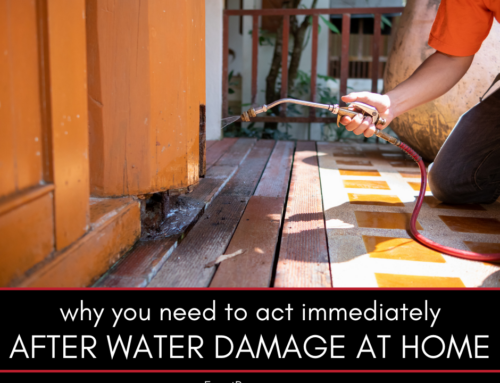Storms can cause significant damage to homes in Michigan, from structural issues to water damage. Understanding the most common types of storm damage and knowing how to address them is crucial for protecting your property.
The Most Common Types of Storm Damage in Michigan Homes
Storm damage can manifest in various ways, each requiring prompt attention to prevent further issues. This guide explains the following:
- Roof damage
- Water damage and flooding
- Wind damage
- Hail damage
- Fallen trees and debris
- Structural damage
- Electrical damage
Here’s a closer look at each.
Roof Damage
One of the most common types of storm damage is roof damage. High winds, heavy rain, hail, and falling debris can all take a toll on your roof. Missing or damaged shingles, leaks, and structural damage are typical issues. Regularly inspecting your roof and making necessary repairs can help prevent further damage. If you notice any roof damage after a storm, it’s essential to call a professional for repairs to ensure your home remains protected from the elements.
Related: Expert tips for dealing with water and fire damage, mold and more
Water Damage and Flooding
Heavy rains and snowmelt can lead to water damage and flooding, particularly in basements and low-lying areas. Water can seep into your home through cracks in the foundation, poorly sealed windows, or clogged gutters. This can cause significant damage to your walls, floors, and belongings. Addressing water damage promptly is crucial to prevent mold growth and structural issues. If you experience water damage, calling a professional for water damage restoration is essential to properly dry and repair your home.
Wind Damage
Strong winds can cause extensive damage to your home and property. Wind can tear off shingles, break windows, and damage siding. It can also cause trees and branches to fall, which can further damage your home. Securing outdoor items and trimming trees near your home can help minimize wind damage. After a storm, inspect your home for signs of wind damage and call a professional for necessary repairs.
Related: Restoring your business after a natural disaster
Hail Damage
Hailstorms can cause significant damage to your home, particularly to the roof, siding, and windows. Hail can dent or crack shingles, siding, and break windows, leading to potential water damage and reduced energy efficiency. Inspect your home for hail damage after a storm and make necessary repairs to prevent further issues. For extensive damage, it’s best to call a professional for thorough inspection and repairs.
Fallen Trees and Debris
Storms can cause trees and branches to fall, which can damage your home, vehicles, and property. Fallen trees can break windows, damage roofs, and create hazardous conditions. Regularly trimming trees and removing dead branches can help reduce the risk of damage. If a tree falls on your home, it’s essential to call a professional for safe removal and repairs.
Structural Damage
Severe storms can cause structural damage to your home, compromising its integrity. High winds, heavy rains, and falling debris can weaken walls, foundations, and support beams. Signs of structural damage include cracks in walls or foundations, sagging ceilings, and doors or windows that no longer close properly. Addressing structural damage promptly is crucial to ensure your home’s safety. Professional restoration services are often required to properly assess and repair structural damage.
Related: How to salvage your belongings after major home damage
Electrical Damage
Storms can also cause electrical damage, leading to power outages, electrical surges, and fire hazards. Lightning strikes, fallen power lines, and water intrusion can all damage your home’s electrical system. After a storm, inspect your electrical system for signs of damage, such as burnt outlets or flickering lights. Avoid using damaged electrical appliances and call a professional electrician to assess and repair any issues.
FAQ About Storm Damage in Michigan Homes
Check out these commonly asked questions about storm damage in Michigan homes. If you don’t see your question here, please call our office and we’ll find you the answers you need.
How Can I Protect My Home From Storm Damage?
To protect your home from storm damage, regularly inspect and maintain your roof, gutters, and siding. Trim trees and secure outdoor items. Ensure your home is well-sealed to prevent water intrusion. Consider installing storm shutters and reinforcing garage doors.
What Should I Do If My Home Is Flooded During a Storm?
If your home is flooded during a storm, turn off the electricity and evacuate if necessary. Remove standing water as quickly as possible and dry out affected areas. Call a professional for water damage restoration to properly dry and repair your home.
Related: Creating a disaster preparedness kit for your home
How Can I Identify Wind Damage After a Storm?
Signs of wind damage include missing or damaged shingles, broken windows, and damaged siding. You may also see fallen branches and debris around your property. Inspect your home thoroughly after a storm and call a professional for repairs if needed.
Is Hail Damage Covered by Homeowners Insurance?
Most homeowners insurance policies cover hail damage, but it’s essential to review your policy details. Document any damage and contact your insurance company to file a claim. A professional can provide an assessment and help with the claims process.
What Are the First Steps to Take After a Tree Falls on My Home?
If a tree falls on your home, ensure everyone’s safety and evacuate if necessary. Avoid the area if there are downed power lines. Contact your insurance company and call a professional for safe removal and repairs. Document the damage for your insurance claim.
Do You Need a Disaster Remediation Expert in Washtenaw County or Jackson County?
If your home has already been damaged, we can help. Check out our services and call Exact Recon for your free disaster remediation quote today. We offer:


